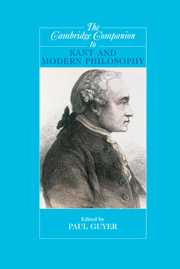Book contents
- Frontmatter
- Introduction: The starry heavens and the moral law
- 1 “A Priori”
- 2 Kant on the perception of space (and time)
- 3 Kant’s philosophy of mathematics
- 4 Kant on a priori concepts: The metaphysical deduction of the categories
- 5 Kant’s philosophy of the cognitive mind
- 6 Kant’s proofs of substance and causation
- 7 Kant and transcendental arguments
- 8 The critique of metaphysics: The structure and fate of Kant’s dialectic
- 9 Philosophy of natural science
- 10 The supreme principle of morality
- 11 Kant on freedom of the will
- 12 Mine and thine? The Kantian state
- 13 Kant on sex and marriage right
- 14 Kant’s theory of peace
- 15 Kant’s conception of virtue
- 16 Kant’s ambitions in the third Critique
- 17 Moral faith and the highest good
- 18 Kant’s critical philosophy and its reception - the first five years (1781-1786)
- Bibliography
- Index
14 - Kant’s theory of peace
Published online by Cambridge University Press: 28 March 2007
- Frontmatter
- Introduction: The starry heavens and the moral law
- 1 “A Priori”
- 2 Kant on the perception of space (and time)
- 3 Kant’s philosophy of mathematics
- 4 Kant on a priori concepts: The metaphysical deduction of the categories
- 5 Kant’s philosophy of the cognitive mind
- 6 Kant’s proofs of substance and causation
- 7 Kant and transcendental arguments
- 8 The critique of metaphysics: The structure and fate of Kant’s dialectic
- 9 Philosophy of natural science
- 10 The supreme principle of morality
- 11 Kant on freedom of the will
- 12 Mine and thine? The Kantian state
- 13 Kant on sex and marriage right
- 14 Kant’s theory of peace
- 15 Kant’s conception of virtue
- 16 Kant’s ambitions in the third Critique
- 17 Moral faith and the highest good
- 18 Kant’s critical philosophy and its reception - the first five years (1781-1786)
- Bibliography
- Index
Summary
In the two centuries since its original formulation, Kant's theory of peace has lost none of its relevance. In fact, because of the recent resurgence of debates about globalization, about the role and mandate of the United Nations, and about the international order after the end of the Cold War, Kant's theory of peace has been steadily gaining attention since 1989.
Kant argues in Perpetual Peace and in the Metaphysics of Morals that true peace is possible only when states are organized internally according to “republican” principles, when they are organized externally into a voluntary league that promotes peace, and when they respect the human rights not only of their own citizens but also of foreigners. He regards these three main requirements as intrinsically connected and argues that they can be successfully met only jointly.
From the moment Perpetual Peace was published, Kant's ideal of a league of states was hotly disputed (when it was not rejected out of hand as wildly unrealistic). The formation of the League of Nations and later of the United Nations has not put an end to the debates. Points of contention persist as to whether the formation of a league of the kind envisioned by Kant is a good idea, and if so, what shape it should have; moreover, there is fundamental disagreement even on what exactly Kant's views are.
- Type
- Chapter
- Information
- The Cambridge Companion to Kant and Modern Philosophy , pp. 477 - 504Publisher: Cambridge University PressPrint publication year: 2006
- 5
- Cited by



